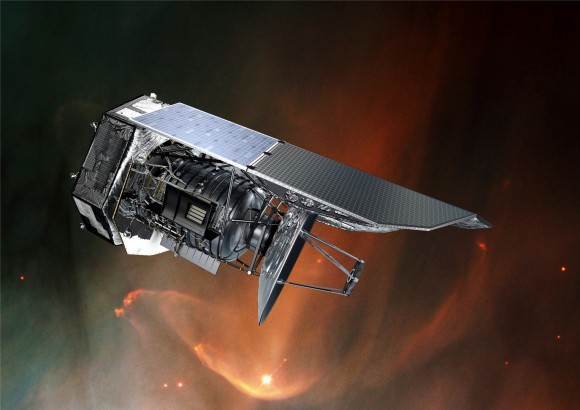Long after telescopes cease operating, their bounty of scientific data continues to amaze. Here’s an example of that: this Herschel Space Telescope image of this dust and gas cloud about 8,000 light-years away.
The examination of NGC 7358 revealed a “weird” dusty ring in the cloud — nobody quite knows how it got there — as well as a baker’s dozen of huge dust clumps that could one day form gigantic stars.
“The 13 clumps spotted in NGC 7358, some of which lie along the edge of the mystery ring, all are more than 40 times more massive than the sun,” NASA stated.
“The clumps gravitationally collapse in on themselves, growing denser and hotter in their cores until nuclear fusion ignites and a star is born. For now, early in the star-formation process, the clumps remain quite cold, just a few tens of degrees above absolute zero. At these temperatures, the clumps emit the bulk of their radiation in the low-energy, submillimeter and infrared light that Herschel was specifically designed to detect.”

More observations are planned to learn about the nature of the dusty ring. So far, astronomers can say it is 35 light-years at its longest axis, 25 light-years at its shortest-axis, and has a mass of about 500 times of the sun. The astronomers took a look at it with the James Clerk Maxwell Telescope in Hawaii to gain some more information.
“Astronomers often see ring and bubble-like structures in cosmic dust clouds,” NASA added.” The strong winds cast out by the most massive stars, called O-type stars, can generate these expanding puffs, as can their explosive deaths as supernovas. But no energetic source or remnant of a deceased O-type star, such as a neutron star, is apparent within the center of this ring. It is possible that a big star blew the bubble and, because stars are all in motion, subsequently left the scene, escaping detection.”
While the research was published in the Astrophysical Journal about a year ago, the image appears to be a new entry on NASA’s and Herschel’s websites. You can also read the paper (led by Cassandra Fallscheer, a visiting assistant professor of astronomy at Whitman College in Walla Walla, Washington) in preprint version on Arxiv.
The Herschel telescope was shut down almost exactly a year ago after the liquid helium that cooled its instruments ran out.
Source: Jet Propulsion Laboratory

